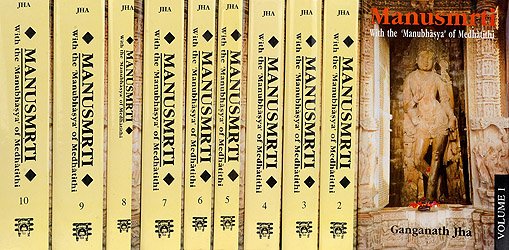Manusmriti with the Commentary of Medhatithi
by Ganganatha Jha | 1920 | 1,381,940 words | ISBN-10: 8120811550 | ISBN-13: 9788120811553
This is the English translation of the Manusmriti, which is a collection of Sanskrit verses dealing with ‘Dharma’, a collective name for human purpose, their duties and the law. Various topics will be dealt with, but this volume of the series includes 12 discourses (adhyaya). The commentary on this text by Medhatithi elaborately explains various t...
Verse 5.15
Sanskrit text, Unicode transliteration and English translation by Ganganath Jha:
यो यस्य मांसमश्नाति स तन्मांसाद उच्यते ।
मत्स्यादः सर्वमांसादस्तस्मान् मत्स्यान् विवर्जयेत् ॥ १५ ॥yo yasya māṃsamaśnāti sa tanmāṃsāda ucyate |
matsyādaḥ sarvamāṃsādastasmān matsyān vivarjayet || 15 ||He who eats the flesh of an animal, is called the ‘eater of its flesh’; he who eats fish is the ‘eater of all kinds of flesh’; hence one shall avoid fish.—(15).
Medhātithi’s commentary (manubhāṣya):
This is a commendatory supplement to the foregoing prohibition of fish.
When one eats the flesh of an animal, he comes to be described as connected with the act of eating that animal; e.g., the mungoose is called ‘serpent-eater’, the cat ‘rat-eater’ and so forth. He who eats fish eats all kinds of flesh; it would be right to speak of him as a ‘beef-eater’ also.
Hence, by reason of the possibility of this calumny, one should avoid fish.—(15).
Explanatory notes by Ganganath Jha
This verse is quoted in Vīramitrodaya (Āhnika, p. 546), which adds that this is an arthavāda to the prohibition of eating fish that has gone before in the preceding verse;—in Smṛtitattva (p. 448);—and in Smṛtisāroddhāra (p. 299).
Comparative notes by various authors
(verses 5.15-16)
Āpastamba (1.17.38-39).—‘Among fish, the Ceṭa should not be eaten;—nor the snake-headed fish or the alligator, or those that live on flesh only, nor those mis-shaped like the Mermen.’
Yama (Vīramitrodaya-Āhnika, p. 546).—(Same as Manu, and also)—‘The following arc unfit for eating—the alligator, serpent,
leech, Madgu, peacock-shaped aquatic animal, small snake-like fish, crocodile, water-hen, and those fish that have ears like the horses, or without scales, or having mouths at both ends.—The student of Veda should avoid all scaleless fish.’
Paiṭhīnasi (Vīramitrodaya-Āhnika, p. 546).—‘The Kulīra, Vārtāka, Pattana, Jalānarta and Kṣipraga are unfit for eating. Fish with scales are eatable; others are uneatable, so also the snakeheaded fish and fish with mis-shaped mouth.’
Vaśiṣṭha (14.41, 42).—‘Among fish, the long-nosed crocodile, the Gavaya, the porpoise, the alligator, the crab, should not he eaten, nor those that are mis-shaped or snakeheaded.’
Devala (Vīramitrodaya-Āhnika, p. 547).—‘Among aquatic animals, Shambu, Śukti, Nakhaśukti, alligator, flying-fish and misshaped fish should not be eaten.’
Hārīta (Do.).—‘Fish that are not mis-shaped (may be eaten).’
Yājñavalkya (1.177-178).—‘Among fish the following may be eaten by the twice-born,—Siṃhatuṇḍa, Rohita, Pāṭhīna and those with scales.’
Gautama (17.36-37).—‘Fish that are not mis-shaped and animals that are slain for the fulfilment of the sacred law.’
Bodhāyana. (1.12-8).—(See under 14)
Viṣṇu (51-21).—(See under 14.)
